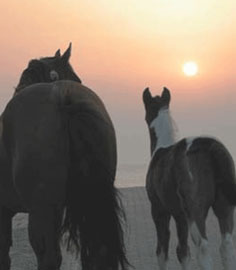
A Horse´s Year…
The whole of a horse’s biological life is geared to the survival of the species. Nature is unconcerned with our plans: she will carry on regardless of what we want, manipulating horses’ minds and bodies, largely through hormonal control, so that they can survive individually in order to procreate as a species.
The horse is a photoperiodic animal, one controlled by the changes in the day length throughout the year, and a long-day breeder, producing young during the longer days. Let us look at what happens to both females and males on a natural, year-round cycle.
WINTER
In winter, many plants and animals are dormant, hibernating or operating on a minimal level, waiting for spring to raise the sap and bring everything to life again.
Horses now have and need their full protective winter coats which will have been set since the end of November. Food is scarce and the sodden, frozen vegetation they can scrape up has little or no feed value: they will be living mainly on the body fat they accumulated during kinder seasons.
As the Winter Solstice passes (the shortest day of the year around December 21 in the northern hemisphere), the horses’ brains sense that they days are, just getting longer. Less and less melatonin is produced, a hormone which suppresses breeding activity, the winter coats begin to thing about casting the horses slowly gear up for reproduction.
SPRING
By spring, these changes are evident as the hormones in both mares and stallions rampage around.
Stallions fight for territory, supremacy and mares, and in-season mares may fight for their stallion’s attention. Last year’s foal, now a yearling, will be chased away should he try to suckle. The winter coats shower out and the smooth summer versions will be sent by May.
The growing grass, high in nutrients, restores weight to thin bodies, provides fuel for the production of mares’ milk and nourishment for foals. The warm, unchallenging days are just what they need to grow and develop.
SUMMER
The mares’ oestrus cycle continues in full swing – if they did not conceive again at the foal heat (the first season after foaling), and many don’t in nature, there is plenty of time for them to try again, or have a year off to recharge.
The grass now takes a dip in nutritional content but the horses will have made up their winter losses and the foals got off to a good start, so this is not critical. Everyone is now at their plumpest and glossiest, concerned with mating and nurturing their next generation.
But summer sees another major turning point in the year – the Summer Solstice or longest day around June 21 in the northern hemisphere. Once again, the brain senses the reduction in the amount of daylight entering the eyes and, very slowly, the horses internal pendulums begin to swing back.
AUTUMN
Now the hormones reduce as melatonin rises, the summers coats are gradually cast the horses lose both their bloom and their interest in, and capacity for, sex.
Oestrus cycles stop and there is a surge in the carbohydrate content of the grass to enable the horses to stock up on body fat for the coming winter – which is where we come in.
